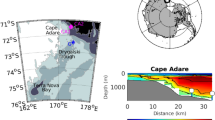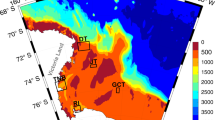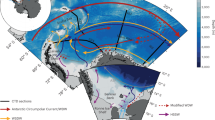Abstract
Dense water formed over the Antarctic continental shelf rapidly descends into the deep ocean where it spreads throughout the global ocean as Antarctic Bottom Water1,2. The coldest and most voluminous component of this water mass is Weddell Sea bottom water1,3,4,5,6,7. Here we present observations over eight years of the temperature and salinity stratification in the lowermost ocean southeast of the South Orkney Islands, marking the export of Weddell Sea bottom water. We observe a pronounced seasonal cycle in bottom temperatures, with a cold pulse in May/June and a warm one in October/November, but the timing of these phases varies each year. We detect the coldest bottom water in 1999 and 2002, whereas there was no cold phase in 2000. On the basis of current velocities and water mass characteristics, we infer that the pulses originate from the southwest Weddell Sea. We propose that the seasonal fluctuations of Weddell Sea bottom-water properties are governed by the seasonal cycle of the winds over the western margin of the Weddell Sea. Interannual fluctuations are linked to the variability of the wind-driven Weddell Sea gyre and hence to large-scale climate phenomena such as the Southern Annular Mode and El Niño/Southern Oscillation.
This is a preview of subscription content, access via your institution
Access options
Subscribe to this journal
Receive 12 print issues and online access
$259.00 per year
only $21.58 per issue
Buy this article
- Purchase on Springer Link
- Instant access to full article PDF
Prices may be subject to local taxes which are calculated during checkout




Similar content being viewed by others
References
Orsi, A. H., Johnson, G. C. & Bullister, J. L. Circulation, mixing, and production of Antarctic bottom water. Prog. Oceanogr. 43, 55–109 (1999).
Legg, S. et al. Improving oceanic overflow representation in climate models: The gravity current entrainment climate process team. Bull. Am. Meteorol. Soc. 90, 657–670 (2009).
Carmack, E. C. & Foster, T. D. On the flow of water out of the Weddell Sea. Deep Sea Res. 22, 711–724 (1975).
Fahrbach, E., Rohardt, G., Schröder, M. & Strass, V. Transport and structure of the Weddell Gyre. Ann. Geophys. 12, 840–855 (1994).
Gordon, A. L. in Ocean, Ice, and Atmosphere: Interactions at the Antarctic Continental Margin 215–240 (Antarct. Res. Ser., eds Jacobs, S. S. & Weiss, R. F. Vol. 75, AGU, 1998).
Meredith, M. et al. On the sources of Weddell Gyre Antarctic Bottom Water. J. Geophys. Res. 105, 1093–1104 (2000).
Nicholls, K. W., Østerhus, S., Makinson, K., Gammelsrød, T. & Fahrbach, E. Ice-ocean processes over the continental shelf of the southern Weddell Sea, Antarctica: A review. Rev. Geophys. 47, RG3003 (2009).
Johnson, G. C. Quantifying Antarctic bottom water and North Atlantic deep water volumes. J. Geophys. Res. 113, C05027 (2008).
Jacobs, S. S., Giulivi, C. F. & Mele, P. Freshening of the Ross Sea during the late 20th century. Science 297, 386–389 (2002).
Rintoul, S. R. Rapid freshening of Antarctic bottom water formed in the Indian and Pacific oceans. Geophys. Res. Lett. 34, L06606 (2007).
Jacobs, S. S. & Giulivi, C. F. Large multi-decadal salinity trends near the Pacific-Antarctic continental margin. J. Clim. 10.1175/2010JCLI3284.1 (in the press, 2010).
Hellmer, H. H., Kauker, F. & Timmermann, R. Weddell Sea anomalies: Excitation, propagation, and possible consequences. Geophys. Res. Lett. 36, L12605 (2009).
Foster, T. D., Foldvik, A. & Middleton, J. H. Mixing and bottom water formation in the shelf break region of the southern Weddell Sea. Deep Sea Res. 34, 1771–1794 (1987).
Gordon, A. L., Visbeck, M. & Huber, B. Export of Weddell Sea deep and bottom water. J. Geophys. Res. 106, 9005–9017 (2001).
Huhn, O. et al. Evidence of deep and bottom water formation in the western Weddell Sea. Deep Sea Res. II 55, 1098–1116 (2008).
Orsi, A. H. & Whitworth, T. III in Southern Ocean Vol. 1 (Hydrographic Atlas of the World Ocean Circulation Experiment (WOCE) (eds Sparrow, M., Chapman, P. & Gould, J.), Int. World Ocean Circ. Exp. Proj. Off., 2005).
Gordon, A. L. et al. in Western Ross Sea Continental Slope Gravity Currents. Deep-Sea Res. Part II 56 (Special issue on Southern Ocean Shelf Slope Exchange, (eds Gordon, A., Padman, L. & Bergamasco, A.)), 796–817 (2009).
Heywood, K. J. & King, B. A. Water masses and baroclinic transports in the South Atlantic and Southern oceans. J. Mar. Res. 60, 639–676 (2002).
Mensch, M, Bayer, R., Bullister, J., Schlosser, P. & Weiss, R. The distribution of tritium and CFCs in the Weddell Sea during the mid-1980s. Prog. Oceanogr. 38, 377–415 (1996).
Ackley, S. F., Geiger, C. A., King, J. C., Hunke, E. C. & Comiso, J. The Ronne Polynya of 1997/98: Observations of air–ice–ocean interaction. Ann. Glaciol. 33, 425–429 (2001).
Timmermann, R., Hellmer, H. H. & Beckmann, A. Simulations of ice-ocean dynamics in the Weddell Sea 2, Interannual variability 1985–1993. J. Geophys. Res. 107, 3025 (2002).
Lefebvre, W., Goosse, H., Timmermann, R. & Fichefet, T. Influence of the Southern annular mode on the sea ice-ocean system. J. Geophys. Res. 109, C09005 (2004).
Visbeck, M. A station-based southern annular mode index from 1884 to 2005. J. Clim. 22, 940–995 (2009).
Hall, A. & Visbeck, M. Synchronous variability in the Southern Hemisphere, sea ice, and ocean resulting from the annular mode. J. Clim. 15, 3043–3057 (2002).
Gordon, A. L., Visbeck, M. & Comiso, J. C. A possible link between the Weddell Polynya and the Southern annular mode. J. Clim. 20, 2558–2571 (2007).
Yuan, X. ENSO-related impacts on Antarctic sea ice: A synthesis of phenomenon and mechanisms. Antarctic Sci. 16, 415–425 (2004).
Yuan, X. & Martinson, D. G. Antarctic sea-ice extent variability and its global connectivity. J. Clim. 13, 1697–1717 (2000).
Simmonds, I. & King, J. C.. Global and hemispheric climate variations affecting the Southern ocean. Antarctic Sci. 16, 401–413 (2004).
Stammerjohn, S. E., Martinson, D. G., Smith, R. C., Yuan, X. & Rind, D. Trends in Antarctic annual sea ice retreat and advance and their relation to El Niño-Southern oscillation and Southern annular mode variability. J. Geophys. Res. 108, C03S90 (2008).
Rintoul, S. et al. in Proc. of OceanObs’09: Sustained Ocean Observations and Information for Society, Venice, Italy, 21–25 September 2009 Vol. 2 (eds Hall, J., Harrison, D. E. & Stammer, D.) (ESA Publication WPP-306, 2010).
Acknowledgements
This research was financially supported under the Cooperative Institute for Climate Applications Research award number NA08OAR4320754 from the National Oceanic and Atmospheric Administration, U.S. Department of Commerce. The statements, findings, conclusions and recommendations are those of the author(s) and do not necessarily reflect the views of the National Oceanic and Atmospheric Administration or the Department of Commerce. Lamont Doherty Contribution number 7369.
Author information
Authors and Affiliations
Contributions
A.L.G. led the data analysis and leads the data collection programme. B.H. supervised the collection and processing of the data reported, and prepared the Methods section. D.M. investigated the relation of the Weddell Sea wind. M.V. contributed to the SAM discussion and was instrumental in the initiation of the Weddell time series.
Corresponding author
Ethics declarations
Competing interests
The authors declare no competing financial interests.
Rights and permissions
About this article
Cite this article
Gordon, A., Huber, B., McKee, D. et al. A seasonal cycle in the export of bottom water from the Weddell Sea. Nature Geosci 3, 551–556 (2010). https://doi.org/10.1038/ngeo916
Received:
Accepted:
Published:
Issue Date:
DOI: https://doi.org/10.1038/ngeo916
This article is cited by
-
Tides regulate the flow and density of Antarctic Bottom Water from the western Ross Sea
Scientific Reports (2023)
-
The role of tides in bottom water export from the western Ross Sea
Scientific Reports (2021)
-
Recent recovery of Antarctic Bottom Water formation in the Ross Sea driven by climate anomalies
Nature Geoscience (2020)
-
Enhanced glacial discharge from the eastern Antarctic Peninsula since the 1700s associated with a positive Southern Annular Mode
Scientific Reports (2019)
-
Reproductive effort in Chaenocephalus aceratus validated by gonadal histology: inshore sites serve as spawning grounds for some notothenioids
Polar Biology (2019)



